-
Posts
1,728 -
Joined
-
Last visited
Content Type
Profiles
Forums
Store
Help Articles
Posts posted by Blether
-
-
Yeah, Duvel introduced Käsespätzle in the 4th post here. Long ago I had a South German mother-in-law whose spaetzle were excellent, though I don't recognise them in the description "thumb-size blobs". They were more like udon in physical form, though with an airier texture..
For me, if we're to be strict, noodle's an English word. The dictionary I have here says it comes from German nudel. On that basis, even ravioli is pushing it
Wikipedia: Noodle is quite informative.
-
Yes, welcome. Please show us some meze!
-
Bacon rolls, then.
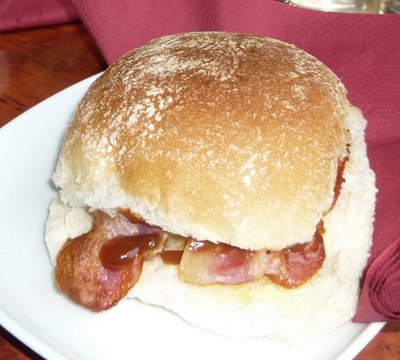
-
Thanks Kim. Your cake looks and sounds delicious. I bet it was.
ETA: British flapjack is very sweet, but good in moderation.
-
Hmm. I could be wrong, he hedged, but that looks like very weak flour, to seem so wet a dough with such a small proportion of water. Still, if it's good to eat, that's the main thing, right?
-
-
In the machine, total cycle ~4.5hrs if I let it run, I'll use about 1/2tsp. Slow rise outside the machine (in summer, about 4.5hrs rising time), a bit less. I haven't found a lower limit yet fo rthe yeast qty.
The machine-only rise is fine. I've posted pics before.
-
PS a tablespoon of SAF Instant? Holy **** batman. about 1/3tsp, here.
-
rotuts, that looks like a low figure overall for water - you're just under 60% hydration. That'll restrict the rise and expose the dough to more ready surface drying. Do you know the gluten percentage of your flour, and how much gluten do you add?
A typical bread recipe starts with 67% hydration for 'strong bread flour' which might have 12-13% gluten or even more. With flour of that strength you should be able readily to increase to over 70% hydration. I make my own toast/sandwich bread at 71% water with flour that has only 11% gluten. I like quite an open crumb.
I'm disappointed that my breadmaker doesn't have a programmable mode or any cycle with a rising time as long as I prefer: so like you, I let the dough rise outside the machine, for flavour.
-
 1
1
-
-
I tried out capellini/fedellini for carbonara:
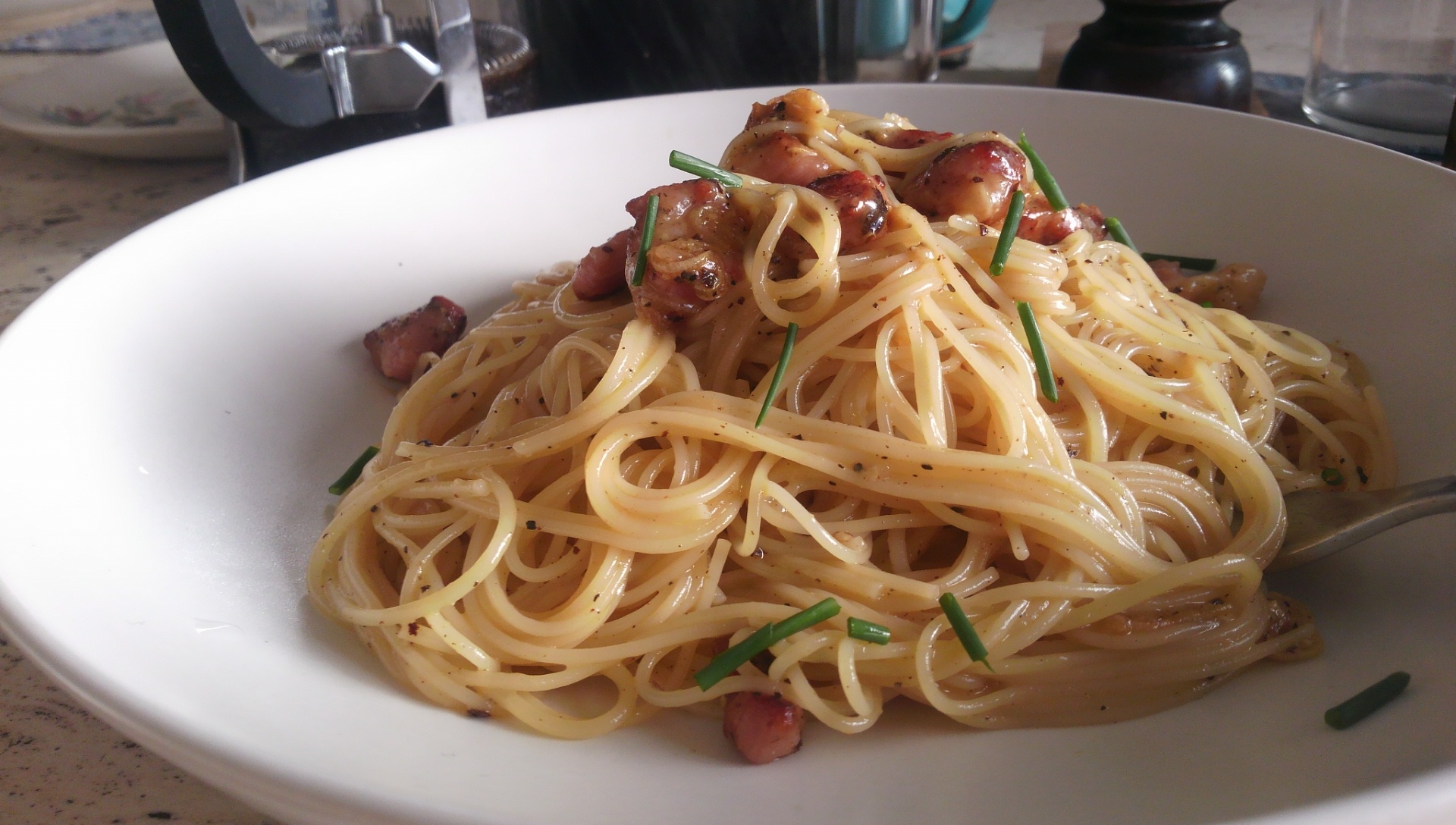
-
 3
3
-
-
A stand-alone deep-fat fryer is the ultimate point-and-shoot. The film even comes in cartridges from the freezer cabinets at the store. You'll always be able to have something tasty and satisfying on the table in twenty minutes with no skill or prep.
-
Thanks. Built-in scales sound good.
I'm still using my breadmaker when I need mixing/kneading (no-knead, I mix by hand now rather than wooden spoon). If I'm *really* busy I'll let it run the whole cycle to finished bread. Having built a special place for it in my new cabinet, though, and now that I'm mostly free-raising and oven-baking my bread, I'm almost wishing I had a food processor instead

-
What parts of the breadmaking process does the Thermomix cover, Anna? It doesn't do the baking, does it? I know nothing about those things.
-
Everything gets product-ised in the end. Nagashi somen, in the wild, looks like this: https://www.youtube.com/watch?v=AZP9gvJvijE
tanoshii = enjoy!
(and flame = frame, at a guess).
Traditionally, the half-pipes are bamboo. Here's another one https://www.youtube.com/watch?v=p7ZzW5fqt-o
It's a summer party thing. Everyone has their bowl of dipping sauce, and off you go. Depending on the size of the venue and event, you can be more or less creative with the scale and layout of the chute network.
-
Did we include nagashi soumen yet? They're iconic. You can even do nagashi spaghetti (that's
not so iconic, though).
-
 1
1
-
-
If you're a single cooking for the freezer, and a beginner, I'd definitely recommend a microwave.
Do Montreal homes typically come with an oven and a broiler?
To what extent are you expecting to get into cooking for the love of it, and to what degree do you want to prepare meals quickly and conveniently?
How much time do you expect to spend at it in a typical day?
What do you see yourself actually preparing and eating? You may not be a cook, but by the look of you you've been eating for a while
 Do you want to keep eating the same way or completely change it up?
Do you want to keep eating the same way or completely change it up? -
Lemon zest. Some broken nuts. Butter or cream.
-
 1
1
-
-
Spaghetti hoops / spaghetti-O's.
-
Thanks, Shelby and thanks, Ann_T. Shelby, the crusts look a bit like your taco shells, don't they?
I was pleased with the tarts. Most of the elements worked out really well, but they're a prototype, a first attempt. The biggest miss was that I'd meant the custard to be deeper, for there to be more of it. So I need a bigger round pastry cutter if I'm using the same size prawns and disposable cupcake cases, or a different form for the crusts altogether.
ninagluck, the crust? Yes, the crusts were excellent, the last couple still crunchy after holding that wet seafood custard for 24 hours.
180g 100% wholewheat bread flour (13.5% gluten, from Canada)
Seasoning - I used salt, a pinch of ichimi / cayenne, a teaspoon or so of lightly-toasted sesame seed (irigoma), ground to a powder. I didn't have sesame oil on hand but I had the seeds.
Oil - enough to give a "fine breadcrumbs" texture to the flour like for shortcrust. I didn't measure: 4 or 5tbsp? worked in with a fork I used safflower oil - it's my choice of the neutral-flavoured oils, I like its neutral flavour best. For flavouring, I infused the prawn heads & peelings in it, hot, for 10 minutes. My approach was to have it bubbling, but not to go so far as to toast the solids. Also, it's oil already - no chilling of fat or flour or bowls for the pastry.
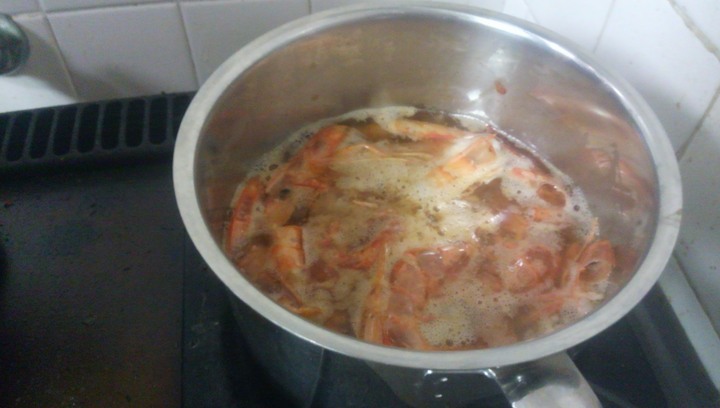
An egg
Enough water to bring the crust together with the fork, then your hands (quite a lot with this strong a flour). The usual pastry game, you need to know how it looks & feels at this stage, so that it will roll out and handle well after resting, and the only way to learn is to do it a few times . You know you didn't use enough water, when you roll out your pastry and it fractures all over the place (I write this because it's a shared forum, Nina, not especially because I think you need it). No kneading, no gathering and rolling. Push the ball down into a thick disk in a plastic bag and rest in the fridge. An hour minimum? I left mine overnight, for other practical reasons.
Rolled out to the thickness you see - 2.5 or 3mm, cut into discs and fitted into those disposable fairy cake / cupcake cases (into the foil part). Left uncovered in the fridge till stiff enough (the sides stiff enough) to lift out onto a wire rack. Leave on the wire rack, again uncovered in the fridge, till dry. Again, this was overnight for me. Put back in the foil cases, use the paper liners for a single layer of (aluminium) baking beads.
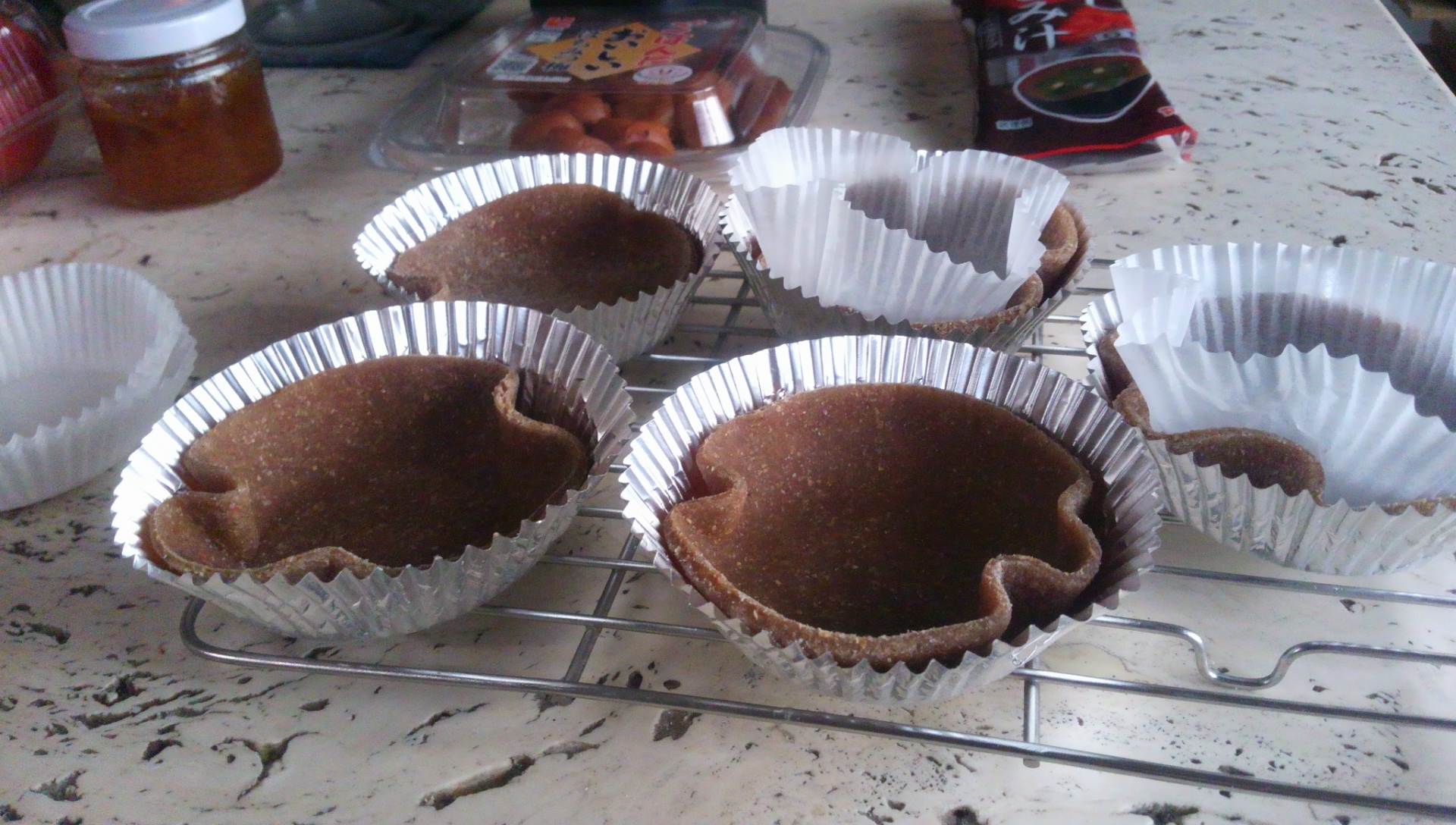
Bake blind for 10 mins at 200C, remove the beans and liners, and continue baking till done (mine took another 5 mins).
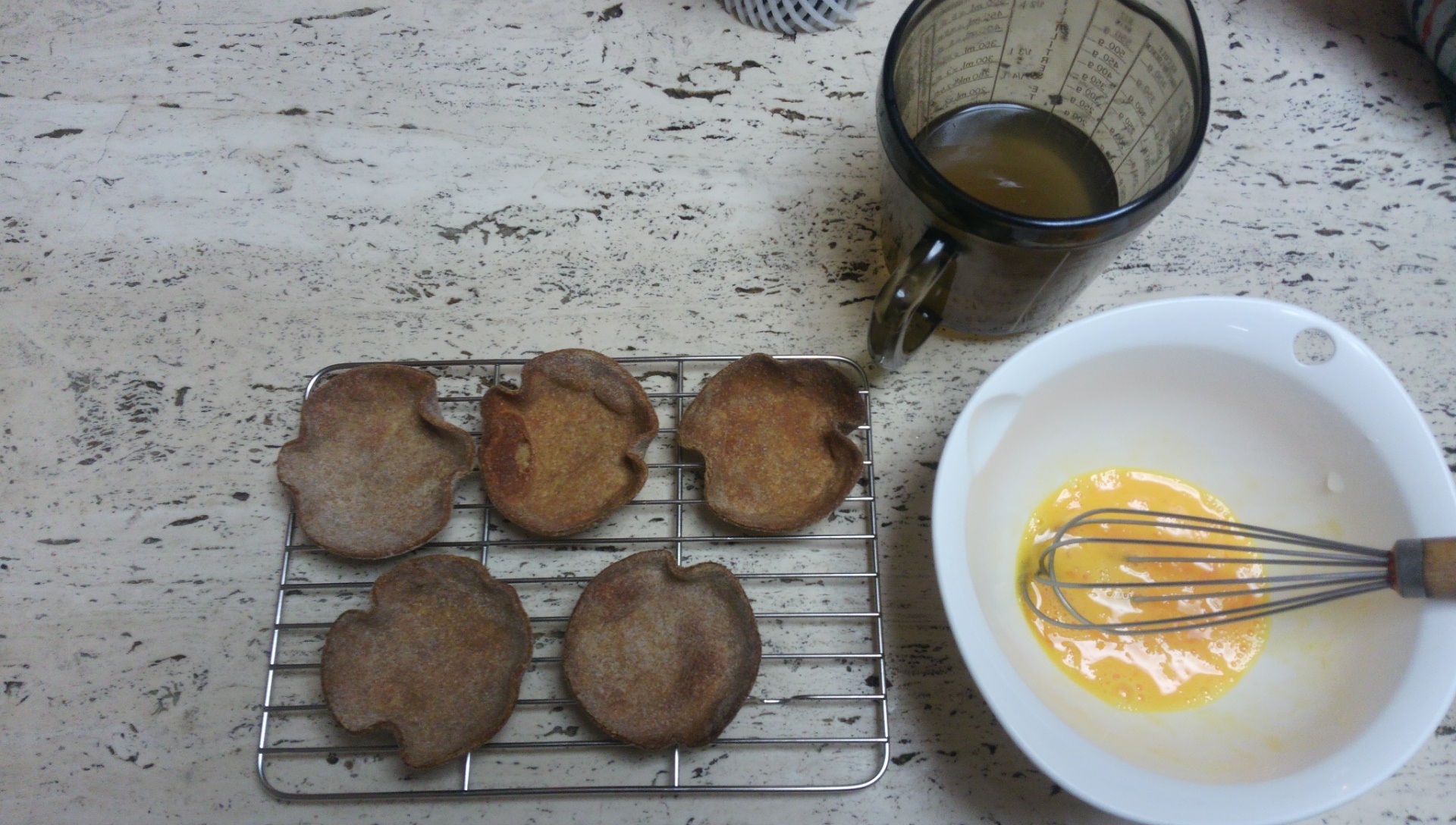
The cases being fully done, I baked the filled tarts at 120C till done - 35 minutes in this instance.
-
 3
3
-
-
Since I've been on a custard roll, some "ebi chawan pies" - prawn and uni in a light hon-dashi custard flavoured with yuzu-koshou (yuzu & green chili). in a crust made from strong wholewheat flour and prawn-carcass-infused safflower oil.
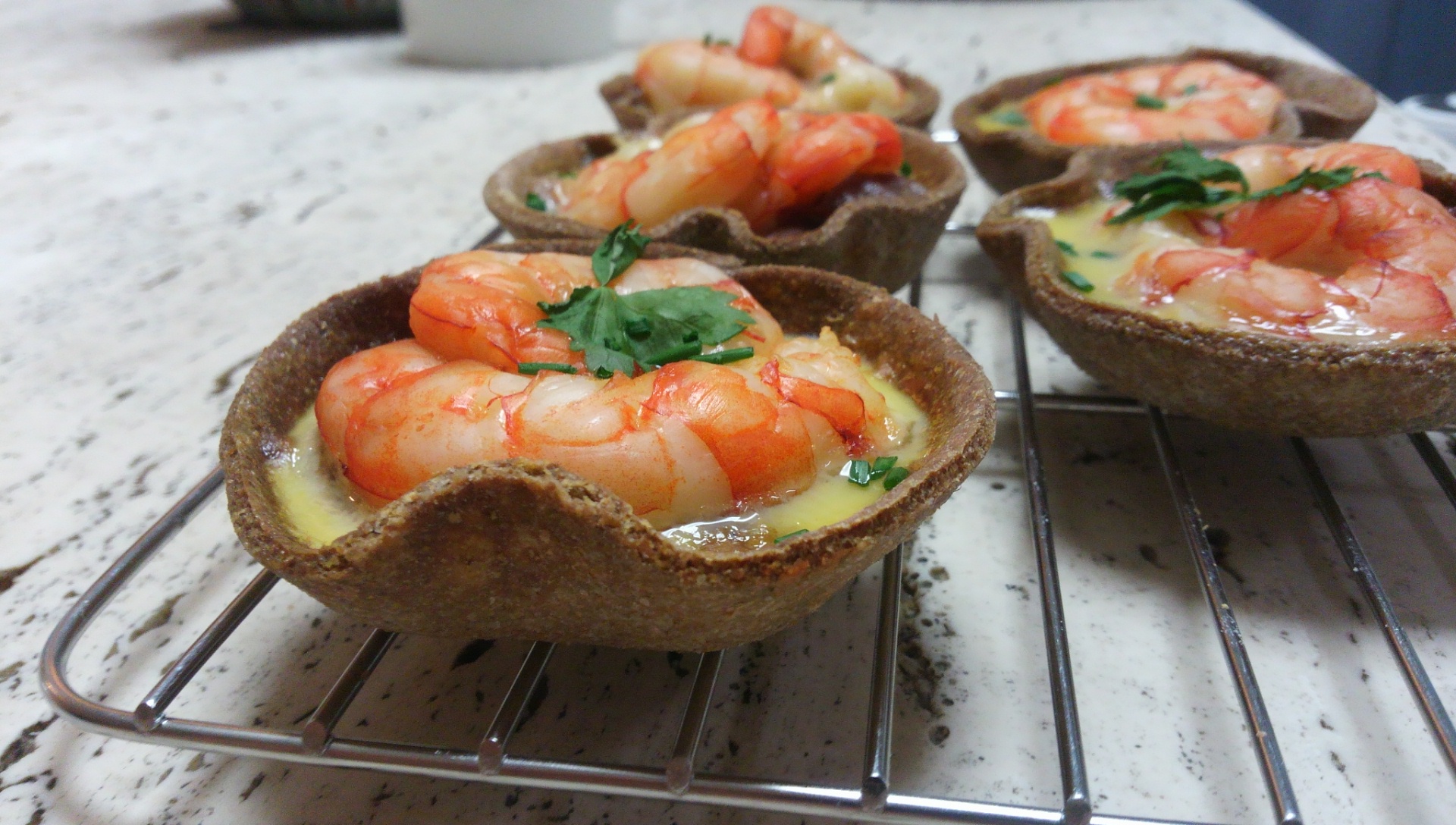
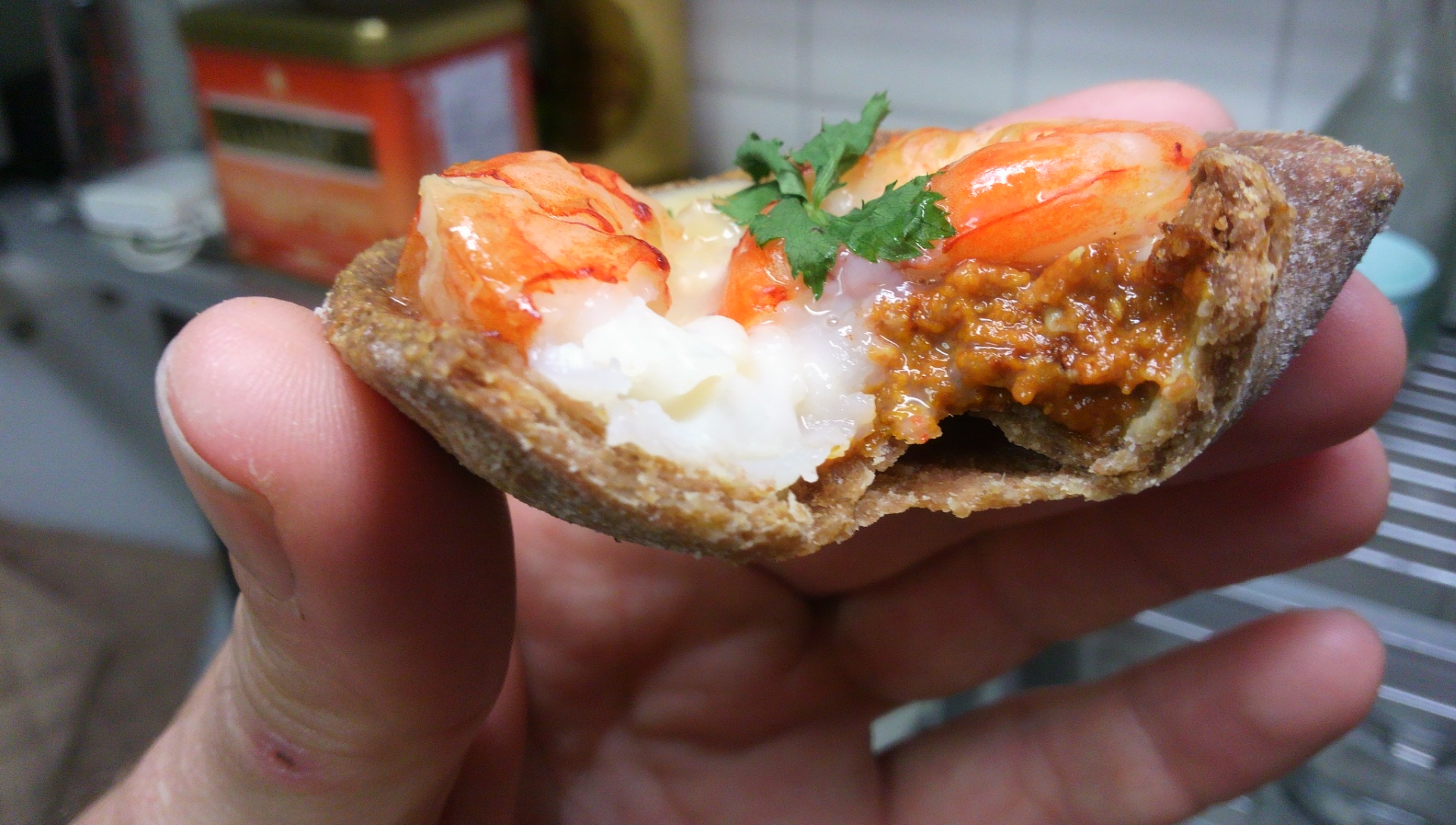
-
 11
11
-
-
There were always pickled eggs, too, at the chip shop: hard-boiled eggs pickled in malt vinegar.
If you google malt vinegar pickles, the first results are actually quite good. The article from The Independent newspaper is authentic, for a start.
-
 1
1
-
-
The tubs are... plastic. Just normal Tupperware-type plastic, but as they are in this marvellously civilised country, marked microwave and freezer compatible and stamped with minimum (-20C) and maximum (140C) temperatures.
JG suggests baking the pate uncovered at 170C, using a water bath, or steaming it covered. It seems to me these two choices are at least as different from each other as they are from a lower-temperature bake without a water bath. I considered microwaving: a google returned a newspaper recipe for a microwave pate, done in 20 minutes cooking, but with interventions to foil the corners and to syringe out fat so the bottom wasn't cooking in a hotter layer.
Now, I'm pretty sure that microwaving at a lower setting would work without the interventions, but in the end not be much quicker or more convenient than that low-temp bake. The bulk of the recipes handed down to us are from a time when ovens didn't reliably hold really low temperatures. I wavered over the temperature but in the end settled on 110C, as low as my combo MW-electric oven goes, excepting the 'ferment' function. No water bath and hey presto, done in 1hr 5mins for the half-full tub, and 1hr15 - 1hr30 for the mounded ones.
OK, so I just dug the unused sixth tub out of the drawer and had a proper read of the base of it. Polypropylene. Lids: polyethylene aka polythene, rated only to 60C. The tubs are also marked "do not use in the oven". Chortle, chortle. Hic!
-
 1
1
-
-
 Well, I've had my share of kitchen reverses lately, Duvel - bread that doesn't rise like it used to, bacon that came out too salty using what iI'd thought was an established process, a first batch of flapjack that fell apart because initially I went back to a recipe that I forgot I'd rejected years ago.So this is lovely surprise, not just good, but fantastic. I have't had such good pate since I was in France: good texture, good mouthfeel, flavour just right. The smell of pudding spices as it came out of the oven was a bit daunting, but cold, no problem. By mid-afternoon I'd gone back and gone back till I'd as good as finished the half-full tub. The one thing I'd change next time would be to put the onions through the mincer too, or chop them that bit finer.It is rich though. With 8 parts belly and 3 parts liver, it didn't help my lap times in the pool last night. It felt like I was swimming in pork fat... which of course I was, really. Luxury.
Well, I've had my share of kitchen reverses lately, Duvel - bread that doesn't rise like it used to, bacon that came out too salty using what iI'd thought was an established process, a first batch of flapjack that fell apart because initially I went back to a recipe that I forgot I'd rejected years ago.So this is lovely surprise, not just good, but fantastic. I have't had such good pate since I was in France: good texture, good mouthfeel, flavour just right. The smell of pudding spices as it came out of the oven was a bit daunting, but cold, no problem. By mid-afternoon I'd gone back and gone back till I'd as good as finished the half-full tub. The one thing I'd change next time would be to put the onions through the mincer too, or chop them that bit finer.It is rich though. With 8 parts belly and 3 parts liver, it didn't help my lap times in the pool last night. It felt like I was swimming in pork fat... which of course I was, really. Luxury.
-
 1
1
-
-
These containers (380ml, about 13.4 imperial ounces or 0.67 UK pints / 2.7 gills) were three-for-a-dollar at the local 24-hour 100yen store.

The obvious thing seemed to be to buy a bunch of them and use them as oven-to-freezer-to-fridge-to-tableware for some proper French-style pate. So that's what I did: I made a batch of pork sausage meat and some lamb sausages at the same time:

Belly & liver minced @ 10mm; about 2/5 reserved for garnish, the rest then minced again at 3/16":











For 1.42kg of meat, I used 1/4tsp quatre epices,1tsp black pepper, 3 cloves of garlic and 9g salt. Otherwise per Jane Grigson's recipe for Pate de Foie / Liver Pate in Charcuterie and French Pork Cookery. I made the QE a classic one, 3g each nutmeg, cloves and cinnamon, and 25g pepper (half black, half white, like a good aubergine).
Does anyone want to know what the end product is like?
-
 6
6
-



Breakfast! 2014
in Cooking
Posted
Some of my home-made French-style pate de foie, per The Terrine Topic..